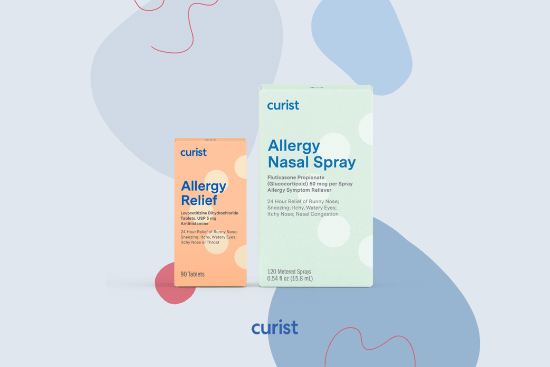By Deni Hui, The University of Texas at Austin College of Pharmacy
Curist delivers over-the-counter medicines to your door at a fraction of the price of traditional brands. We hope everyone stays safe and healthy during this time.
You may have seen both Xyzal (levocetirizine) and Flonase (fluticasone) in the allergy relief aisle of your local pharmacy. Have you ever debated which one to purchase? Have you ever wondered what the differences are between Xyzal vs Flonase?
What is Xyzal? What is Flonase? Is Xyzal the Same as Flonase?
Xyzal (levocetirizine) is an oral antihistamine that helps block the effects of histamines in your body. Histamine is normally released when your body detects something harmful. In people who suffer from allergies, the body mistakes something harmless such as pollen, pet dander, dust, or mold, for a threat. Histamine release is what causes an allergic reaction with unpleasant symptoms including itchy, watery eyes, a runny nose, skin rashes, hives, and/or sneezing.
Flonase (fluticasone) is a nasal steroid spray specifically designed to offer relief from nose and eye-related allergy symptoms. It works right in your nose to help block your allergic reaction at the source and to relieve symptoms that make you uncomfortable.
Xyzal is not the same as Flonase. Even though they overlap in several of the symptoms they relieve such as itchy, watery eyes, runny nose, and/or sneezing, they work in entirely different ways.
What is the Difference Between Xyzal and Flonase (levocetirizine vs fluticasone)?
There are several key differences between Xyzal and Flonase. Let’s take a look!
Mechanism of Action: Xyzal vs Flonase
Xyzal, the oral antihistamine, blocks only the actions of histamine in your body when it is exposed to an allergen. Histamines are then blocked from causing more symptoms in your body.
Flonase, the nasal steroid spray, has a different mechanism of action than that of an oral antihistamine, like Xyzal. When an allergen enters your body through your nose and triggers a response from your immune system, it results in the release of inflammatory substances that cause your allergic symptoms. Flonase acts to block 6 of these inflammatory mediators, including histamine, to treat the swelling and symptoms that have already occurred as a result of histamine release.
Allergic Symptom Relief: Xyzal vs Flonase
Xyzal treats several allergy symptoms, including runny nose, sneezing, itchy and watery eyes, itchy nose, and itchy throat. In comparison to Xyzal, Flonase does not treat itchy throat, but does relieve nasal congestion. So Flonase would be the best choice if your allergy symptoms include nasal congestion.
How Long It Takes To Work: Xyzal vs Flonase
Xyzal and Flonase both provide 24-hour symptom relief. However, considering the different ways these two products work, Xyzal has a faster onset of action and can start working within the first hour you take it, while Flonase can take 3-4 days before it builds up to full effectiveness.
Both provide 24-hour allergy symptom relief, and are designed to take on a daily schedule to maintain effectiveness throughout the allergy season.
Which is Better, Xyzal or Flonase? Is Levocetirizine or Fluticasone Better?
Xyzal and Flonase are both effective in relieving a broad range of symptoms from many indoor and outdoor allergens (like pollen in spring allergy season or ragweed in fall allergy season). Both provide no or minimally drowsy relief for 24 hours. The specifics of which Flonase or Xyzal is better depends on your symptoms. Research has shown that Flonase is more effective for nasal congestion whereas Xyzal is more useful for itching nose, throat, or watery eyes.
What is the Difference in Side Effects between Flonase and Xyzal (levocetirizine or fluticasone)?
The key difference in side effects between Xyzal and Flonase is their likelihood to cause drowsiness. Xyzal is classified as a third generation antihistamine which has the lowest chance for drowsiness of all antihistamines, but it still can cause drowsiness in some people, while Flonase is non-drowsy across the board.
In some cases, like in elderly populations, oral antihistamines like Xyzal can cause dryness. Oral antihistamines treat runny noses by drying up excessive mucus, but some may experience unwanted dryness overall. If this tends to happen to you, try using Flonase (fluticasone) instead to treat your allergies and runny nose.
Can I Take Xyzal and Flonase at the Same Time?
Yes, the good news is that Xyzal and Flonase can in some cases work together to offer compounded relief for severe allergy symptoms. For instance, Flonase can offer nasal congestion relief while Xyzal can provide relief to itchy nose, or throat at the same time.
At Curist, our Allergy Drip-Duo offers exactly this pairing of medicines, levocetirizine and fluticasone. It is ideal for light to medium allergy sufferers who find that relief from an oral antihistamine may not be enough.
Where Can I Buy Xyzal and Flonase Online?
The over-the-counter versions of levocetirizine and fluticasone are available in local pharmacies as well as stores online like Curist, and do not need a prescription.
At Curist, we develop FDA-approved equivalents to big brands in order to provide the same medicine relief but at half the price of the brands. Curist products are sold online and shipped directly to your door, and we carry both levocetirizine (compare to Xyzal) and fluticasone (compare to Flonase).












